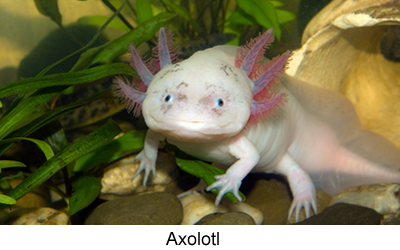 |
|
Name:
Axolotl Classification:
Class: Amphibia
Order: Caudata
Family: Ambystomatudae
Genus: Ambystoma
Species: A.
mexicanum
Size: 4 to 9 inches
long. Characteristics:
Wide salamander-like body, feathery gills on the side of the head, fins,
two eyes, four very small legs, long tail. Status:Critically
Endangered possibly Extinct in the Wild.
Looking more like a Pokémon than an animal, the axolotl is one of the most unique creatures on Earth. This species of amphibian is one of the mole salamanders. Axolotls are unusual as they retain some of their larval characteristics for the duration of their lives. In other words, they never fully grow up! This phenomenon is called neoteny. It restricts the axolotl from ever leaving the water. The feathery gills, fins, non-protruding eyes, lack of eyelids and constant aquatic adaptations are all characteristics that other amphibians lose as they grow. However, some axolotls have been known to shed their gills and live on land. In addition to its Peter Pan lifestyle, the axolotl is unique because of its regeneration abilities. That's right, these creatures are capable of re-growing entire limbs in a matter of weeks! As a result, the axolotl has been the focus of many scientific studies across the world. Males are usually larger than females. The axolotl is able to reproduce at about 18-24 months. The females lay eggs on plants or other objects, which hatch after two or three weeks. Young axolotls feed on algae, while older individuals feast on crustaceans, worms, fish and other water critters. Axolotls live in the thick vegetation of lakes and canals, the remains of Lake Xaltocan and what used to be Lake Chalco. Once numerous, the axolotl has experienced an accelerated decrease in population. Their habitat has been largely drained and polluted. To make matters worse introduced fish preys upon them. In 1998 the Mexican Academy of Sciences estimated that there were 6,000 axolotls per square kilometer. By 2008 that number had dropped to 100. It was beginning to look as if the axolotl had vanished from the wild until a research team discovered two wild individuals in 2014. This gives hope that this bleak situation may yet be reversed. Though the species is nearly extinct in the wild, it is a common exotic pet, often owned in captivity in a variety of colors. While this could restart their population, some fear that releasing captive axolotls in the wild could lead to genetic mutations. In any case scientists continue to research the amphibian's regeneration properties. Some cleaner portions of their scarce habitat have been set aside to provide safe havens. This sheds some light in an otherwise dark situation. The axolotl may yet live to swim another day. If you want to learn more about axolotls and help them in their time of need, check out these awesome organizations: ICUN Red List of Threatened
Species-Axolotl Page EDGE of Existence-Axolotl
Page |
|
|
|
|
||
|
Contact
Us
|
||||
|
Taproot
Guru © ALL RIGHTS RESERVED
|
||||